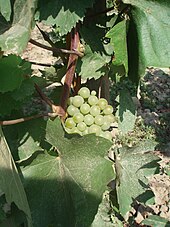Hungarian wine
Hungarian wine has a history dating back to the Kingdom of Hungary. Outside Hungary, the best-known wines are the white dessert wine Tokaji aszú (particularly in the Czech Republic, Poland, and Slovakia) and the red wine Bull's Blood of Eger (Egri Bikavér).
Etymology

Only three European languages have words for wine that are not derived from Latin: Greek, Basque, and Hungarian.[1] The Hungarian word for wine, "bor", is ultimately of Middle Persian origin.[2]
History
The Romans brought vines to Pannonia, and by the 5th century AD, there are records of extensive vineyards in what is now Hungary. The Hungarians brought their wine-making knowledge from the East. According to Ibn Rustah, the Hungarian tribes were familiar with wine-making a long time before the Hungarian conquest of the Carpathian Basin.[3]
Over the following centuries, new grape varieties were brought in from Italy and France. Most of the production was of white wine in that period.

During the Ottoman occupation of Hungary, an ancient variety of grapes was used to make the robust red-wine blend later known as Bikavér (Bull's Blood), after a supposed secret ingredient in the wine that fortified the defenders of Eger in 1552.[citation needed]
It was also during the Turkish occupation that the Tokaj region became known for dessert wines,
After the Ottoman Empire ceded Hungary to the Austrians in 1699, the Germanic influence was felt with the introduction of grape varieties such as Blauer Portugieser. That influence also showed [citation needed] in the start in 1730 of the world's first vineyard classification in Tokaj, based on soil, aspect and propensity to noble rot.
From 1882, the
Wine regions and styles

The official list of wine regions is defined by a ministerial decree. The current list includes 22 wine regions, which are usually grouped into five to seven larger regions.[4]
- Balaton, with sub-regions
- Badacsony: volcanic soils, full-bodied whites with considerable acidity. One of the few sources of Kéknyelű grapes.
- Balatonboglár: full-bodied whites and reds with moderate acidity.
- Balaton-felvidék: volcanic soils, full-bodied whites with considerable acidity.
- Balatonfüred-Csopak: terra rossa soils, full-bodied whites with considerable acidity.
- Olaszrizling, Hárslevelű and Furmint.
- Zala: mainly white wines.
The main variety of the region is
- Duna, with sub-regions
Mainly fresh and light wines from many varieties.

- Eger, with sub-regions
- Bükk: mainly white wines.
- Kékfrankos. Good Pinot noirs.
- Olaszrizling and Chardonnay.
- Észak-Dunántúl, with sub-regions
- Neszmély: fresh and aromatic whites.
- Etyek-Buda: fresh white wines, with considerable acidity.
- Mór: volcanic soil, full-bodied whites. Main variety: Ezerjó.
- Pannonhalma: full-bodied whites.
- Kékfrankos).
- Pannon, with sub-regions
- Cirfandli
- Cabernet franc, Merlot
- Tolna
- Villány: robust, full-bodied, spicy reds. Main varieties: Blauer Portugieser, Cabernet Sauvignon, Cabernet Franc, Merlot and occasionally Pinot Noir.
- Sopron, with sub-regions
- Tokaj


Hungary's most famous wine region lies in the foothills of the Zemplén Mountains of the far north of the country; in fact the traditional area crosses into the southeast corner of modern Slovakia. The area is notable for its long warm autumns and mists that come in from the River Bodrog, creating perfect conditions for noble rot. This can contribute towards creating the botrytised (aszú) grapes for which the region is famous. These are individually picked as late as mid-November into buckets (puttonyos) and crushed to a paste. Varying amounts of this aszú paste are then added to non-aszú must or wine made from a mix of Furmint, Hárslevelű, Muscat Blanc à Petits Grains, Kövérszőlő or Zéta grapes, and left to ferment. The resulting wine is then aged in relatively small barrels in a labyrinth of cellars in the soft volcanic tuff, on whose walls thick blankets of fungus regulate the humidity.[5]
Given that aszú conditions only happen in perhaps three vintages per decade, much dry Furmint is also produced. Other grapes grown in the area include Hárslevelű, Muscat Blanc, Kövérszőlő and Zéta.
For centuries the main product of the area was the sweet wine, mainly the botrytised selections. The dry Furmint drew the attention of the world's wine connoisseurs and experts when the Úrágya 2000 single vineyard selection was introduced by István Szepsy. The wine expressed great minerality, complexity and structure, which has been experienced only in the finest white wines of historic regions like Burgundy or the Mosel before. The aging potential was also promising. In 2003 more producers of Mád village produced single vineyard selected dry Furmint wines with great success. Mád village, with its almost 1200 ha, had the opportunity to produce high quality dry Furmint wine in significant quantity as a commune level wine, which can express the unique volcanic terroir of the region, this wine is named after its appellation Mád and produced by István Szepsy Jr. in the Szent Tamás Winery.
Hungarian grape varieties

Several varieties of grape are known to have originated in Hungary. These are:
- Ezerjó
- Hárslevelű
- Irsai Oliver
- Cserszegi fűszeres
- Királyleányka
- Zenit
Other varieties of grape that may have originated in Hungary include:
See also
References
Rebbe Nachman of Breslev on Hungarian Wine "The Breslov Center". Archived from the original on December 31, 2011. Retrieved December 27, 2012.
- ^ Miklós Molnár, A concise history of Hungary, Cambridge University Press, 2001, p. 12.
- ISBN 963709401 6.
- ISBN 9780854042661.
- ^ "127/2009. (IX. 29.) FVM rendelet a szőlészeti és a borászati adatszolgáltatás, valamint a származási bizonyítványok kiadásának rendjéről, továbbá a borászati termékek előállításáról, forgalomba hozataláról és jelöléséről" (in Hungarian). Nemzeti Jogszabálytár. 27 December 2012. Retrieved 27 December 2012.
- ^ Atkin, Tim (2001) Tradition and Innovation in the Tokaj Region Dissertation for Master of Wine.
External links
- Wine Reviews - Independent wine blog
- The Hungarian Wine - Rebbe Nachman of Breslev story about Hungarian Wine


